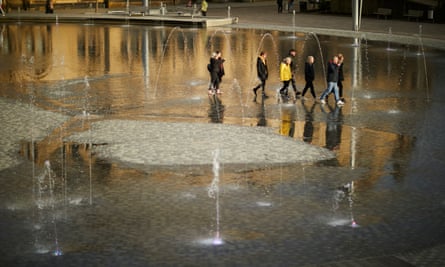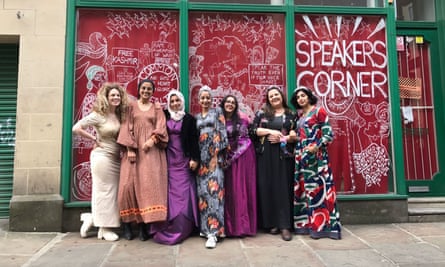When it comes to grim urban statistics in Britain, the city of Bradford tops many lists. Police statistics name Bradford as having the highest crime rates in West Yorkshire, while a 2014 YouGov poll named it Britain’s “most dangerous city”. Bradford also has one of the highest levels of youth unemployment in the UK: 26% of young people were out of work in 2015, up from 11.3% in 2004.
What makes these statistics particularly troubling, however, is the one that ties them all together. More than 30% of the population here are currently under the age of 20, and the city has the highest number of under-16s in the country, giving Bradford the unusual title of being the UK’s youngest city.
To Adam Mathers, 17, that means one thing: overcrowding.
“It’s too small and crowded here, people feel there’s no way out,” says Mathers, who was born and raised in the city and is now one of the 20,000 students at Bradford College. “Young people are always competing for the same jobs. There isn’t much ambition.”
With nearby Leeds a more attractive prospect for young jobseekers – it is the second largest employment centre outside of London, and home to the headquarters of global companies including Asda, Tetley and First Direct – those who stay in Bradford have limited options. After the closure of the city’s textile mills, its largest employer, the majority of jobs in Bradford now fall into skilled trades, retail and administrative sectors.
“Bradford moves in slow motion,” says second-generation British Pakistani, Essen Shaffi. The 18-year-old also attends the college, taking A Levels in English literature and psychology. “It will always be trailing behind places like Leeds, especially since most follow the careers or wishes of their parents.”

Mathers, who is pursuing a diploma in sport, agrees: “My brother became a plumber like my dad, and a lot of people are pressured to be like their family – or they just go for the first job they can get.”
“A lot of our students don’t leave Bradford, they don’t go out of this bubble,” says the college’s head of health and social care, Wesley McGlinchey. “We’ll take them on trips to the seaside because they’ve never seen sand or the sea. You have to open their eyes to the world and help them develop aspirations.”
That’s difficult when Bradford is also facing an unprecedented budget crisis due to austerity. The council’s revenue support grant, which was £183m in 2013/4, will be eliminated by 2020.
Since the launch of the city centre area action plan in 2015, which proposes investing £75m until 2030, infrastructure has developed rapidly. Near the college is City Park, with its vast paved “mirror pool” – the UK’s largest urban water feature – and the subterranean shopping halls of Sunbridge Wells, alongside the Westfield-owned Broadway centre. Future investment plans include creating a business centre near City Park, 3,500 new homes, and renovations to the Bradford Interchange and Forster Square railway stations.
Although the council is investing to try to improve the city, many young people feel it doesn’t affect them.
“City Park is nice to look at but for young people it’s just another place to hang around and get into trouble,” Mathers says. “A couple of people I know have been arrested for robbery and a few are currently on bail. It’s not because they’re bad kids, it’s because where they’ve been brought up there’s nothing else to do. The options are equal between getting a job or getting into crime.”
“While investments make the city a more pleasant place to live, the simultaneous cuts in the council budget have affected youth services,” McGlinchey says. “You can cope with your bins not being collected every week, but things like social services for young people can never go.”

One reason for the increased numbers of young people in Bradford is its consistently high rate of immigration. It has the largest Pakistani population in England and is also currently home to 781 asylum seekers who are awaiting a decision on their claim.
Ulmeera Kaur, 18, arrived in September 2017 from Afghanistan. She sees Bradford as a safe haven, rather than a city lacking in opportunity.
“It feels like a new home here,” she says. “There aren’t many Afghanis but there are Pakistanis who I can speak to in Punjabi and Urdu. There’s no better feeling than being able to express yourself in your own language, and I wasn’t expecting to find that in a foreign country.”
The experience for 18-year-old Estegenet Sermolo has been more difficult. Since arriving unaccompanied from a French refugee camp a year ago, acculturating has been a challenge. “I want to be with people from my country who I can speak my language to, but there aren’t any Ethiopians here,” she says. “I don’t have a social life outside of college – it’s an isolating experience.”

While Kaur wishes to remain in Bradford and train to become a dermatologist, Sermolo is seeking to study elsewhere in the UK and then return to Ethiopia.
This isolation has led to racial tensions among young people. “Bradford is a very area-oriented place,” says Mathers. “It’s split into the BD postcodes. For instance, if you go to my area, BD2, there’s a mix of ethnicities, but in places like BD10 it’s very Muslim. You stick to your area. And that leads to young people always going around in large groups, which creates a threatening atmosphere.”
Shaffi, however, sees the group mentality as communal rather than threatening. “When you’re born and bred here, you develop a real community,” he says. “In my area everyone knows everyone else”.
Mehmoona Pervaz, 16, believes the lack of support for young people stems from a misunderstanding between different generations and cultures. “Bradford is a diverse city but lots of people still don’t understand each other,” she says. “They might look at me wearing a hijab and think I won’t be able to speak English or I won’t have had an education. People won’t understand us unless they take the time to speak to us. We also need to prove that the youth has something to give back to the community.”

Pervaz was one of 10 women aged 13 to 20 who co-founded an organisation that is seeking to change the foreboding narrative for young Bradfordians. Operating out of unheated office space, arranged by the council, next to a derelict branch of KFC, the Speakers’ Corner Collective was launched last year to tackle the lack of mental health support for young people.
The collective, which takes its name from Bradford’s historic Speakers’ Corner that disappeared after the second world war, has since helped organise the Bradford Women of the World festival and is working on a panel with the Bradford NHS Trust on youth health services.
Pervaz found solace in the collective after suffering from an eating disorder. “The group has helped us develop as women in so many ways,” she says. “I didn’t realise I had a mental health problem until I came here and admitted it for the first time and broke down in tears. To think that two years ago I was just a simple girl from Bradford, and now I use my voice to make a change in the city, is amazing.”
Speaker’s Corner’s premises are not permanent: they may have to leave if a tenant is found, though they are confident that the council would support them to find a new location. Regardless, co-founder Madeyah Khan, 16, remains resolute. “Bradford is its own city, it has its own identity,” she says. “Speaker’s Corner is about finding our own voices and using them. There’s nothing the council can do to stop us; if they shut us down I’ll stand on the street corner and say what needs to be said.”
With the population estimated to grow by an average of 2,000 people a year for at least the next 10 years, the inherent problem facing Bradford’s youth – too many people competing for too few jobs – will continue.
Mathers has his eye on moving to London or to the US, to pursue a career in American football. “The next generation of Bradford isn’t promising, because everyone will settle too easily,” he says. “Bradford will stay the same as it’s always been.”
- This article was amended on 5 February 2018 to clarify that the Speaker’s Corner Collective premises were provided by Bradford Council and to remove a reference that suggested the organisation did not receive council support
Follow Guardian Cities on Twitter, Facebook and Instagram to join the discussion, and explore our archive here

Comments (…)
Sign in or create your Guardian account to join the discussion